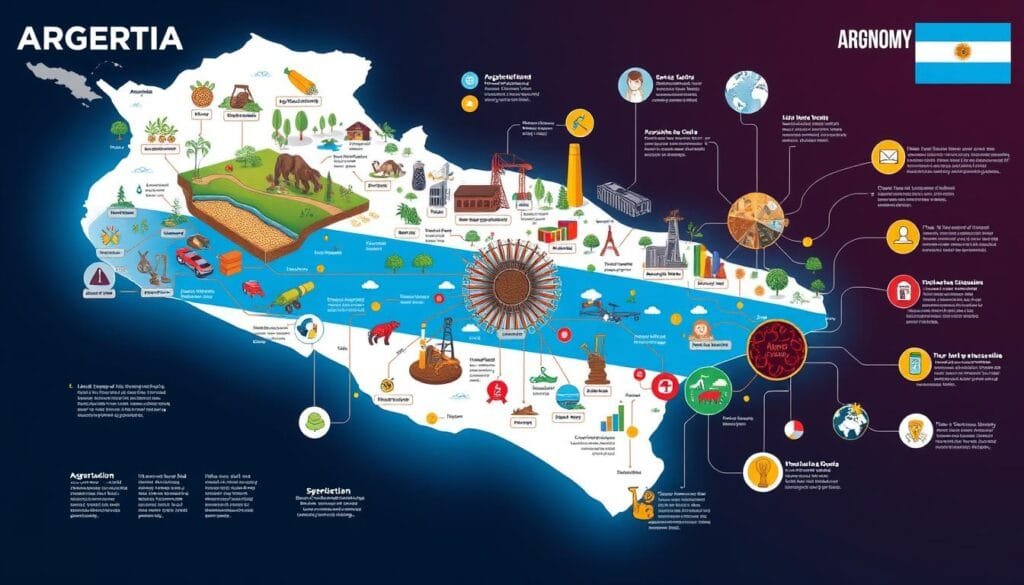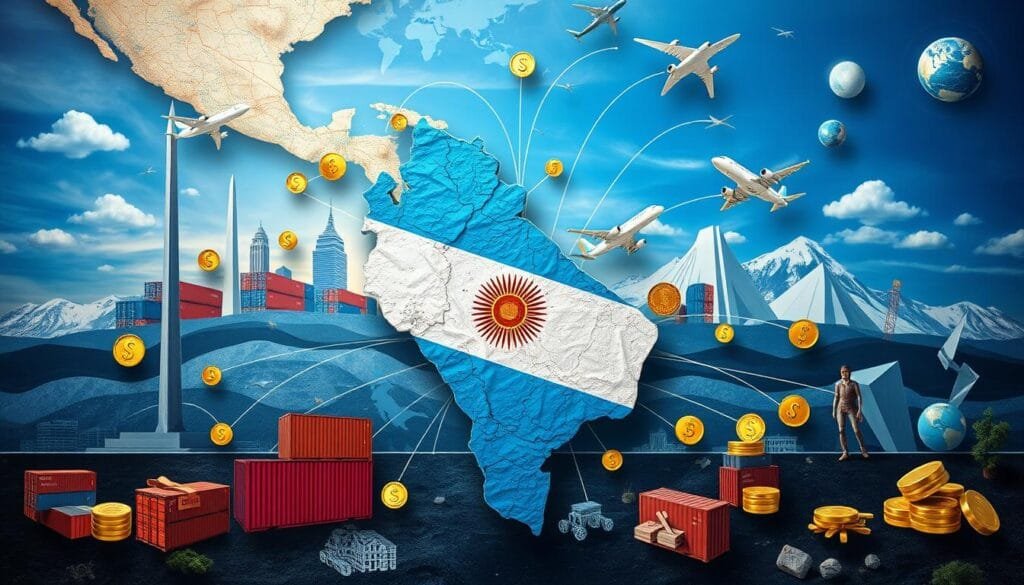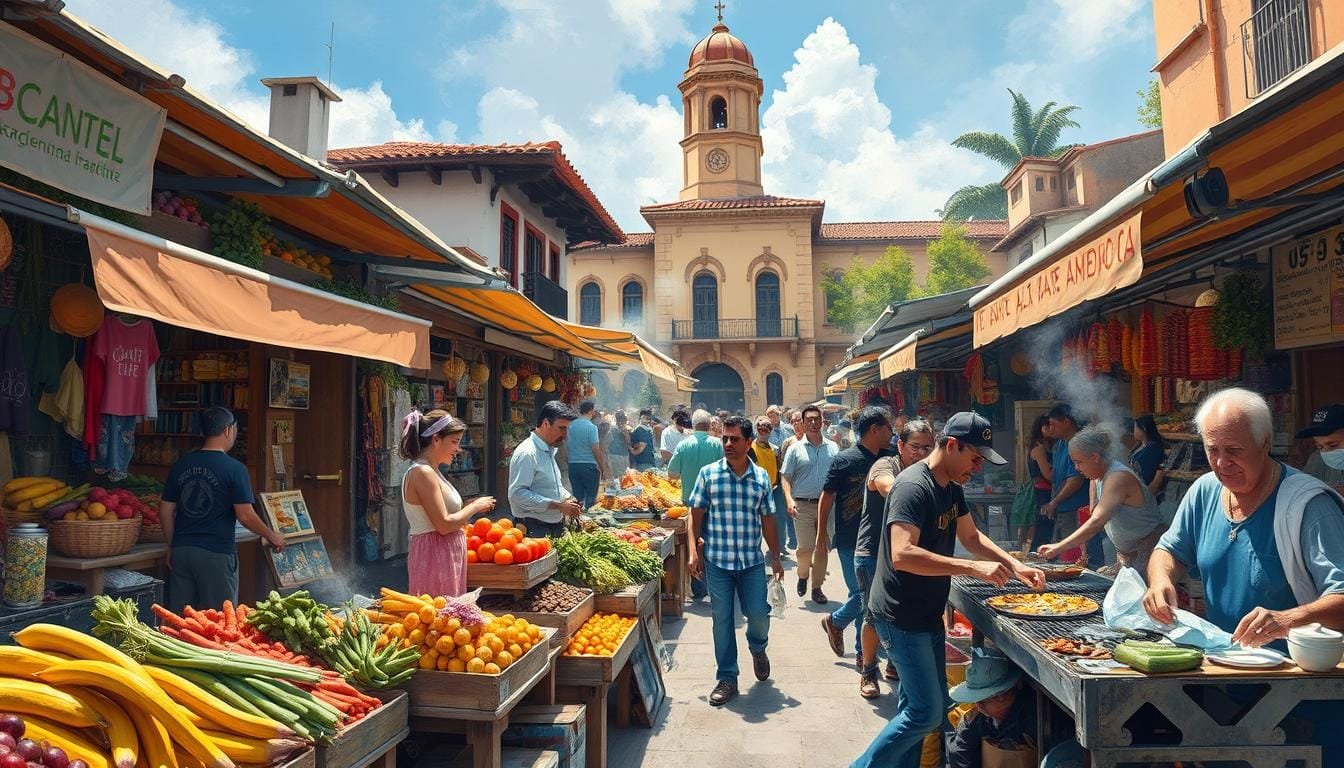Exploring Argentina’s economic structure reveals the complex forces shaping its market. The country is rich in natural resources and has a history of wealth. Yet, it faces ongoing economic ups and downs.
Argentina has a strong background in agriculture. It has also expanded into industry and services. But, financial challenges like inflation continue to affect it. The nation’s economy has seen both prosperous times and periods of hardship. Understanding its economics is key to knowing its place in the world today.
Key Takeaways
- Explore the richness of Argentina’s natural endowments and cultural heritage mirrored in its economic narrative.
- Understand the historical shift from a primary focus on agriculture to a broad-based economy with significant industrial and service sectors.
- Grasp the underlying causes of Argentina’s persistent financial challenges such as inflation and currency instability.
- Recognize the impact of political fluctuations and international relations on Argentina’s market dynamics.
- Discover how Argentina’s economic structure continues to evolve in the face of global market demands and internal reforms.
The Historic Overview of Argentina’s Economic Journey
Exploring Argentina’s economy shows a transformation from farming to big industrial growth. This change impacted local and global markets alike. In the early days, Argentina’s agriculture, focusing on the fertile Pampas, led in exporting wheat, corn, and meat by the 20th century. This farming success brought a lot of foreign money, strengthening Argentina’s economic foundation.
From Agricultural Powerhouse to Industrial Expansion
In the early 20th century, Argentina’s farming sparked wider economic activities. This led to growth in industries. At first, the focus was on food processing because of the agricultural boom. Later, Argentina aimed to diversify its economy under government plans. This shift aimed to buy less from other countries, supported by policies to boost industries like petroleum, steel, and transportation.
The Impact of Political Turmoil and Economic Policies
Political ups and downs have often disturbed Argentina’s economy. Military rule and changing government policies shaped its economic path. Different economic ideas, from state intervention to reducing debt, show how politics complicated Argentina’s economic situation.
The Great Depression and Import Substitution Industrialization
The Great Depression deeply affected Argentina’s exports, leading to a focus on producing goods domestically in the 1930s. This aimed at making the country self-reliant but had mixed results. By the 1960s, Argentina made many goods itself but also faced big foreign debts and its farming was no longer as competitive globally, upsetting economic balance.
Looking at Argentina’s economy through the growth of agriculture, industries, and import substitution gives a full picture of its history and challenges. This background helps understand Argentina’s current economic position and hurdles in the world market.
The Structure of Argentina’s Economy
Exploring Argentina’s economic landscape shows a dynamic mix of key sectors. These include agriculture, technology, industry, and services. With a GDP around US$640 billion, Argentina stands out in Latin America. It’s key to see how each area adds to the economy and what it means for growth.
Key Sectors: Agriculture, Industry, and Services
Argentina’s economy features agriculture, industry, and service sectors. A severe drought caused a significant drop in agricultural exports. Yet, this sector still represents about 6% of GDP. Manufacturing takes up about 15% of the GDP. It covers various industries, from auto to tech innovations.
The service sector leads by contributing 53% to the GDP. This includes growth in finance and retail. It also shows the expanding tech sector that puts Argentina on the world stage.
Argentina’s Role in Global Markets: Agriculture and Technology
Argentina stands out globally with its agriculture and technology. It’s a top provider of soybeans and beef. This keeps the world fed despite challenges. Argentina is also growing in technology. It’s focusing on software and biotechnology. This diversifies its economy and strengthens its global presence.
Importance of Tourism and Renewable Energy
Tourism has become crucial for Argentina’s economic health. Millions are drawn to its culture and scenery. This boosts the GDP and shows a model for balanced growth. The country is also embracing renewable energy. This promotes sustainable growth and matches global eco-friendly trends.
Looking at Argentina’s economy, we see how sustainable practices and tech innovation mix with traditional sectors. This includes agriculture and tourism. Such an approach promises growth and a stable economic future for Argentina.

Current Economic Challenges Facing Argentina
Argentina faces tough economic challenges, like high Argentine inflation, large foreign debt, and political instability. Adding to the difficulties is a continuous fiscal deficit. These issues make it hard for Argentina to stabilize and grow.
Inflation and Its Historical Roots
Inflation is a big problem for Argentina’s economy, expected to hit 210% by 2023. This problem started with past economic policies that focused on short-term solutions. With the Central Bank’s reserves running low in 2023, it’s clear this problem isn’t going away anytime soon.
The Debt Dilemma and Its Impact on the Economy
Argentina’s story is also about its big foreign debt. A fiscal deficit of 4.4% of GDP in 2023 shows problems with governance and money management. Efforts to control money flow and limit imports have hurt the economy’s ability to work with the world market.
The Influence of Political Instability on Economic Performance
Political instability has constantly affected Argentina. Changes in government have led to different economic policies. For example, with the shift to a right-wing Libertarian government, there has been a push to cut public spending. This included a big 36% cut in non-discretionary spending, like pensions, compared to last year.
Here is a table showing key economic indicators for Argentina:
| Indicator | Value (2023-2024) | Impact/Area Affected |
|---|---|---|
| Inflation Rate | 210% | Economic Stability |
| Fiscal Deficit | 4.4% of GDP | Governance and International Credit |
| Gross Public Debt | 89.5% of GDP | National Solvency |
| Non-Discretionary Spending Cut | 36% | Social Welfare Programs |
| Foreign Exchange Reserves Depletion | Significant | Import Capacity/Currency Stability |
how is economic system in argentina
To really get Argentina’s economy, we need to look closely at several important aspects. This includes current numbers that show how things are going. It helps us get the full picture of Argentina’s money world.

The country’s economy is influenced by its budget rules and how it deals with foreign money rules. The peso’s worth and dollar swap rules play a big role. Let’s dive into some key economic facts:
| Indicator | Ranking | Description |
|---|---|---|
| GDP per capita | 86th | Reflects average economic output per person. |
| Unemployment Rate | 127th | Measures the percentage of the labor force that is unemployed. |
| Gini Index | 40th | Indicates the level of income inequality within the country. |
| Public Debt | 86th | Expresses the total amount of money owed by the government. |
| External Debt | 9th | Highlights the amount of funds borrowed from foreign entities. |
| Electricity Consumption per Capita | 68th | Shows average electricity usage per person. |
Looking at these stats, Argentina’s external debt is especially high, ranked 9th in the world. This shows Argentina often faces money challenges and borrows a lot from other countries. This situation, mixed with strict rules on foreign currency, makes the economy complex.
With this in mind, how the peso’s value ties in with things like inflation and debt is clear. It shows us the struggle to keep the country’s economy stable. This affects both businesses and people living in Argentina.
The Role of International Relations and Trade Agreements
Argentina plays a key role in international trade. It uses its economic policies to build strong partnerships worldwide. This helps Argentina in agriculture and industry, making it important globally.

The history of trade between Argentina and countries like the United States shows how trade has grown. Since 1823, the countries have worked to improve trade and cooperation. For example, a deal in 2007 made more flights possible, boosting tourism and business.
Let’s look at some key trade numbers for Argentina:
| Year | Exports (USD Billion) | Imports (USD Billion) | Trade Balance (USD Billion) |
|---|---|---|---|
| 2022 | 88.4 | 81.5 | +6.9 |
| 2023 | 66.7 | 73.7 | -6.9 |
These facts show how big Argentina’s role is in world trade. They also show how global economic relations can change. Argentina works with organizations like the WTO and the IMF. This helps improve how it deals with other countries.
Building strong partnerships is very important for Argentina. It is working to sell more types of products. Managing trade policies well helps Argentina stay strong in world trade. This keeps Argentina moving forward, even as global trade changes.
Conclusion
In our deep look at Argentina’s economy, we’ve explored major challenges that shaped its financial condition. The economy’s story is filled with ups and downs since 1850, reaching a crucial moment in 2024. With a poverty rate at 57%, the need for change is clear. Yet, the slowing inflation offers hope for improvement.
Under President Javier Milei, Argentina has seen bold actions like budget cuts, leading to a surprising surplus in January. His approach marks a clear change from past policies. With the 2024 harvest expected to bring in more foreign currency, people are cautiously hopeful. But those struggling with poverty and inflation need to see real changes soon, ideally by May 2024, as Milei has indicated.
Our analysis shows that inclusive political institutions lead to economic success. This reveals the urgency for Argentina to strengthen its political and legal systems for better stability and growth. Considering its past as one of the wealthiest countries, Argentina’s focus should be on improving governance and law enforcement. The country must deal with political challenges, economic issues, and untapped potentials to advance globally.
FAQ
What are the main components of Argentina’s economic structure?
The service sector, manufacturing, and agriculture shape Argentina’s economy. The service sector leads in GDP and jobs. Agriculture is key, with Argentina being a top producer of grains and cattle in Latin America. The country also excels in industrial fields like food processing and electronics.
How did Argentina’s past economic policies shape its current financial challenges?
Past focus on import substitution industrialization hurt the agricultural sector and increased foreign debt. Political issues and economic mismanagement led to high inflation and instability.
What impact did the Great Depression have on Argentine agriculture?
The Great Depression hit Argentine agriculture hard, reducing its export markets. This struggle led to a shift towards import substitution industrialization for economic self-sufficiency.
What role does tourism play in Argentina’s economy?
Tourism boosts Argentina’s economy. It attracts visitors with its culture and nature. This includes historic sites, cafes, and beautiful landscapes.
How does inflation currently affect Argentina, and what are its historical roots?
In 2023, inflation in Argentina surpassed 120%. This inflation comes from past economic policies and mismanagement. It causes higher living costs and affects purchasing power.
What is the Blue Dollar Rate and why is it significant in Argentina?
The Blue Dollar Rate is an unofficial exchange rate. It’s crucial because the government restricts foreign currency exchange. This leads to an informal economy and savings in US dollars.
How do international relations and trade agreements impact Argentina’s economy?
International relations and trade agreements significantly impact Argentina’s economy. They shape Argentina’s role in global markets, affecting agricultural and industrial exports.
